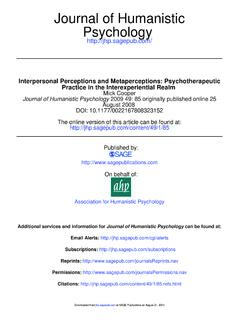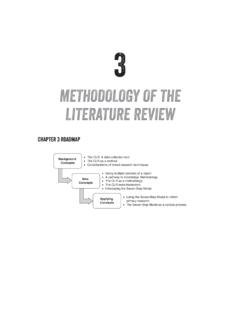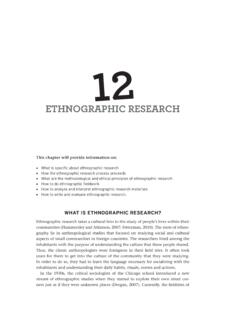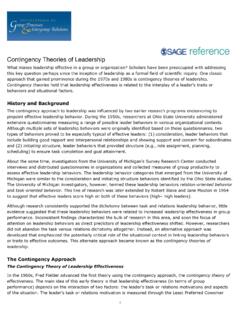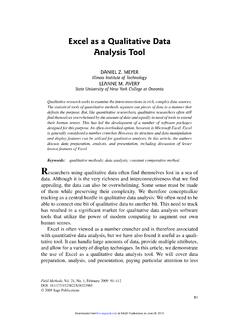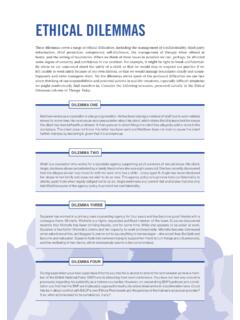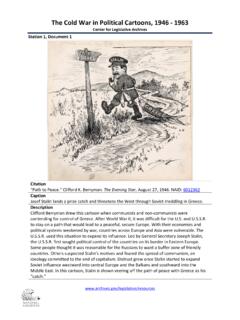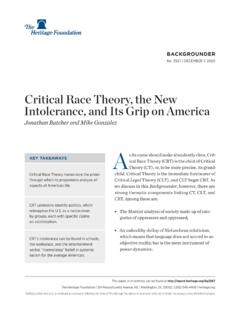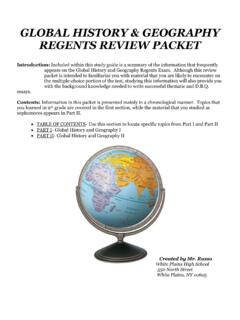Transcription of Leadership Effectiveness - SAGE Publications Inc
1 SIDEBARS: Leadership Effectiveness asViewed by James FenimoreCooperLeadership EffectivenessAdelphia Communications, John Rigas, CEO; AOL Time Warner, Robert Pittman, CEO; ArthurAndersen, joseph Berardino, CEO; Bristol Myers, Fred Schiff, CEO; Citigroup, Sanford Weill, CEO;Enron, Ken Lay, CEO; Merrill Lynch & Co., David Komansky, CEO; Qwest Communications, JosephNacchio, CEO; Sunbeam, Al Dunlap, CEO; Tyco International, Dennis Kozlowski, CEO, and the listgoes on companies that were icons of success have now become icons of dramatic failure, unethicalpractice, or simply bad judgment. One day these companies and their leaders were lauded as the embodiments of leadershipeffectiveness and the next day as embodiments of what is wrong with the concept of Leadership Effectiveness is difficult to define because it is a complex concept that attempts to capture myriadcomponents: multiple organizational contingencies and various personal and interpersonal behaviors.
2 Here we shall attempt anormative definition and explain how its many components help us grasp a complex define the concept of Leadership Effectiveness in many ways. Indeed, Stogdill (1974), Bass (1981), and Bass and Stogdill(1990) catalogued and interpreted almost five thousand studies of the concept and found great variance in its definition. Burns (1978)captured the problem most vividly in a statement still widely quoted today: Leadership , he said is one of the most observed andleast understood phenomena on earth (Burns 1978, 2). People seem to accept a default position that Leadership is simply whatleaders do and that leaders are simply people in positions of power over others. An alternative to this position will be offered , we must have a starting point for our understanding of Leadership Effectiveness even if it means that almost immediately wewill create inclusive definition of Leadership Effectiveness is the successful exercise of personal influence by one or more people that resultsin accomplishing shared objectives in a way that is personally satisfying to those involved.
3 This definition arouses controversy whenexamined from perspectives based on behavior in different contexts. Although this definition most comfortably applies to theinterpersonal, small-group, and network levels found within typical work environments, in almost all political arenas and in some hugeorganizations, Leadership Effectiveness will be defined organizations in which members or employees are significantly affected by decisions and actions that take place at a distance withonly representative participation at best, Leadership Effectiveness is the successful exercise of personal influence attempts by one ormore people that results in accomplishing organizational objectives congruent with a mission while earning the general approval oftheir constituencies (in the case of political Leadership ) or stakeholders (in the case of business and civil society organizations).Stakeholders are people who have an interest in an both cases, the definition's several conceptual components require further explanation because each has inspired a literature of itsown to help clarify its meaning and to help us understand how to use it appropriately.
4 SUCCESSFUL EXERCISE OF PERSONAL INFLUENCE BY ONE OR MORE PEOPLE A limited view of Leadership sees it as a set of behaviors and functions specifically tied to one role or formal position. Holding thisview, one would expect that only the CEO could be the leader. A somewhat wider view would recognize that Leadership of a division, acommittee, a department, or an office is equally important for the accomplishment of organizational goals because each person'swork contributes to achieving the overall purpose of the organization. The broadest view of Leadership recognizes that everyone whoexercises his or her personal influence, whether selecting office supplies, choosing a site for the company picnic, or deciding thelocation of a new plant, could be engaging in , the interaction among people before a consensus is reached or simply during the process of working together results inincremental, often subtle influences that occur so quickly that the combined result of the collective exercise of influence is leadershipby the group itself rather than by any one individual.
5 Consider the performance of a planning committee. Even when it has a formalleader or convener, inevitably the input of each member, as influenced by others through discussion and decision making along theway, results in the group as a whole creating a plan no one could have managed alone. Thus, the planning committee effectivelyleads the larger organization when its work is THAT RESULTS IN ACCOMPLISHING SHARED OBJECTIVES Using influence unilaterally because one has the legitimate organizational right to do so is more illustrative of the use of intimidationthan interpersonal influence freely accepted by others. The distinction is important because accomplishing shared objectives requiresthe participation of relevant people in the decision-making process or their tacit, if not explicit, acceptance of decisions made on theirbehalf. Organizations have a huge number of objectives distributed to every person and unit.
6 To meet this criterion and to build thetrust of each employee or member in the management of the organization, the organization should have a clearly articulated visionand mission. In that way, each person will know whether any particular decision or objective will help achieve the overallorganizational purpose. Thus, each person, even if not directly involved in making every decision or in creating every objective, canstill feel that objectives are shared when they sensibly fit the vision and mission. IN A WAY THAT IS PERSONALLY SATISFYING TO THOSE INVOLVED Although effective Leadership requires the accomplishment of the organization's objectives that serve its vision and mission in a waythat is personally satisfying to those involved, both the degree to which objectives are accomplished and the satisfaction of thoseinvolved are quite subjective. Indeed, often inherent contradictions and conflicts make it virtually impossible to please everyone allthe time.
7 An organization that is meeting its financial targets but at the same time laying off people creates such a contradiction. Acompany that is registering many new high-tech inventions while its stock price drops precipitously is experiencing a conflicted stateperceived by some as success (therefore indicative of effective Leadership ) and by others as failure (therefore indicative of ineffectiveleadership).STAKEHOLDER VIEW OF Leadership EFFECTIVENESSA bout the only statement that can be made about Leadership Effectiveness with any certainty is that, more often than not, it is in theeye of the beholder. In large organizations, the various objectives being served reflect the importance of serving diverse appears obvious at first that the objective of business is to increase the bottom line, or that the objective of a political party isto elect candidates becomes rather complex and muddled when seen in the midst of either surviving in the marketplace orcampaigning for the case of political parties, we can readily understand the various constituencies and interests that must be convinced.
8 In thebusiness world, stakeholder interests that once included only the investment community and the board of directors now includeemployees, customers, suppliers, regulators, local communities, civil society organizations, and even competitors in some cases whenjoint ventures or the development of industry standards is considered. Leadership Effectiveness at the top of an organization is nolonger seen as simply increasing the bottom line or satisfying any one priority because there are equally important, if competing,interests to be , at other levels in the organization, Leadership Effectiveness is subject to a diversity of objectives. Work flow andinterdepartmental decisionmaking processes, the pursuit of mutual efficiency targets and the development of external relationshipswith key stakeholders ( , customers and suppliers) are different objectives from those that are created within a work team or thatserve the interests of one's own department and staff.
9 All of this suggests that Leadership Effectiveness includes a dimensionassociated not only with just one's followers but also with one's OF INFLUENCE IN ADDITION TO LEADERSHIPIf we see influence style as the personal product of one's power and values disposition as a continuum of possibilities, we can thendistinguish several forms of influence. In other words, a value important to a person is translated into a belief system that causesone's behavior, in this case one's form of influence. Nirenberg (2002) identified six forms of personal influence in organizations. (SeeTable 1.) He classified only one of these forms as distinctions result in various behavioral styles used by an individual or a position holder within a group be it at the level ofthe organization, division, department, bureau, shop, and so forth. With this understanding, however, not all forms of influenceshould be defined as Leadership as we discuss that behavior here.
10 Identifying various forms of influence helps us make a cleardistinction between the conventional wisdom of Leadership as positionship (regardless of the form of influence) and Leadership asjust one process of interpersonal this perspective is new, it helps us more accurately frame the discussion by being more precise about what we mean whenwe talk about Leadership Effectiveness especially within the context of employee-based organizations in a democratic, free-marketsociety. With this perspective, we clearly reject German Nazi leader Adolf Hitler, Soviet leader joseph Stalin, and Cambodian leaderPol Pot as leaders, although surely they were tyrants and dictators. Influential? Yes. However, their influence was largely based onthreat, coercion, intimidation, and mass murder. We must also reject Albert Dunlap (CEO, Sunbeam) and joseph Nacchio (CEO,Qwest) as failed, if not criminal, CEOs for maintaining their position of power through the economic equivalents of mass murder(layoffs) and rape (asset stripping).
